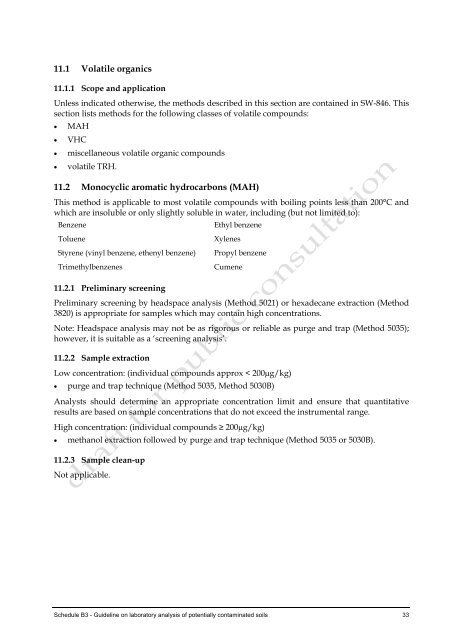Schedule B3 - COAG Standing Council on Environment and Water
Schedule B3 - COAG Standing Council on Environment and Water
Schedule B3 - COAG Standing Council on Environment and Water
- No tags were found...
You also want an ePaper? Increase the reach of your titles
YUMPU automatically turns print PDFs into web optimized ePapers that Google loves.
11.1 Volatile organics<br />
11.1.1 Scope <strong>and</strong> applicati<strong>on</strong><br />
Unless indicated otherwise, the methods described in this secti<strong>on</strong> are c<strong>on</strong>tained in SW-846. This<br />
secti<strong>on</strong> lists methods for the following classes of volatile compounds:<br />
• MAH<br />
• VHC<br />
• miscellaneous volatile organic compounds<br />
• volatile TRH.<br />
11.2 M<strong>on</strong>ocyclic aromatic hydrocarb<strong>on</strong>s (MAH)<br />
This method is applicable to most volatile compounds with boiling points less than 200°C <strong>and</strong><br />
which are insoluble or <strong>on</strong>ly slightly soluble in water, including (but not limited to):<br />
Benzene<br />
Toluene<br />
Styrene (vinyl benzene, ethenyl benzene)<br />
Trimethylbenzenes<br />
11.2.1 Preliminary screening<br />
Ethyl benzene<br />
Xylenes<br />
Propyl benzene<br />
Cumene<br />
Preliminary screening by headspace analysis (Method 5021) or hexadecane extracti<strong>on</strong> (Method<br />
3820) is appropriate for samples which may c<strong>on</strong>tain high c<strong>on</strong>centrati<strong>on</strong>s.<br />
Note: Headspace analysis may not be as rigorous or reliable as purge <strong>and</strong> trap (Method 5035);<br />
however, it is suitable as a ‘screening analysis’.<br />
11.2.2 Sample extracti<strong>on</strong><br />
Low c<strong>on</strong>centrati<strong>on</strong>: (individual compounds approx < 200μg/kg)<br />
• purge <strong>and</strong> trap technique (Method 5035, Method 5030B)<br />
Analysts should determine an appropriate c<strong>on</strong>centrati<strong>on</strong> limit <strong>and</strong> ensure that quantitative<br />
results are based <strong>on</strong> sample c<strong>on</strong>centrati<strong>on</strong>s that do not exceed the instrumental range.<br />
High c<strong>on</strong>centrati<strong>on</strong>: (individual compounds ≥ 200μg/kg)<br />
• methanol extracti<strong>on</strong> followed by purge <strong>and</strong> trap technique (Method 5035 or 5030B).<br />
11.2.3 Sample clean-up<br />
Not applicable.<br />
<str<strong>on</strong>g>Schedule</str<strong>on</strong>g> <str<strong>on</strong>g>B3</str<strong>on</strong>g> - Guideline <strong>on</strong> laboratory analysis of potentially c<strong>on</strong>taminated soils 33
















